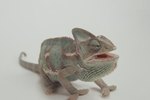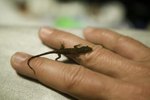
Of the nearly 6,000 species of lizard known worldwide, most are diurnal creatures that spend portions of their day basking in the sunlight. A handful of species have a different lifestyle, and have evolved to hide during the day and become active at night. Geckos are the most noteworthy group of nocturnal lizards, though a few species are diurnal. Other examples include desert night lizards (Xantusia vigilis vigilis) and the peculiar prehensile-tailed skinks (Corucia zebrata) of the Solomon Islands.
Leopard Geckos
Leopard geckos (Eublepharis macularius) are medium-sized geckos, native to Afghanistan, Pakistan and western India. Differing from the typical geckos, leopard geckos lack adhesive toe pads, and are terrestrial rather than arboreal. Leopard geckos spend their days hidden under rocks and other cover to avoid predators like foxes and birds of prey. The geckos emerge shortly after sunset to pursue their invertebrate prey. A variety of geckos, including banded geckos (Coleonxy sp.), wood geckos (Diplodactylus vittatus) and African fat-tailed geckos (Hemitheconyx caudicinctus) also have terrestrial, nocturnal lifestyles.
Tokay Geckos
Tokay geckos (Gekko gecko) are large members of the family Gekkonidae. These lizards are primarily insectivorous and consume moths, roaches and beetles. Additionally, tokay geckos, which can reach 12 inches from snout to vent, are large enough to consume small lizards, birds and frogs as well. Tokay geckos spend their day hidden among bark or under palm fronds, but like similar geckos, are still able to maintain appropriate body temperatures and thermoregulate effectively by moving through different microhabitats.
Desert Night Lizards
Desert night lizards and their close relatives are peculiar lizards that inhabit dry ecosystems of the American Southwest. Though these insectivorous lizards are diurnal or crepuscular during cool seasons, they become nocturnal in the heat of summer; a strategy common to many other reptiles of arid habitats. Night lizards have unusual reproductive and life history traits: the young are born live, rather than hatching from eggs, and will remain with their parents in small family groups for at least the first year of life.
Prehensile-tailed Skink
Prehensile-tailed skinks (Corucia zebrata), also called monkey-tailed lizards, are a rare example of a nocturnal herbivore. After spending the day clinging to the main trunk of a tree, prehensile-tailed skinks spend their nights climbing around the canopy of a tree consuming leaves. Very different from most living skinks, the genus Corucia diverged from their closest ancestors approximately 30 million years ago. Prehensile-tailed skinks give live birth to one or two juveniles, and may not reproduce every year.
References
- Copeia: Comparative Ecology of Twelve Species of Nocturnal Lizard (Gekkonidae) in the Western Australia Desert
- Herpetologica: Light Versus Heat: Thermoregulatory Behavior in a Nocturnal Lizard (Gekko Gecko)
- Reptile Database: Species Numbers
- CalifroniaHerps.com: Xantusia Vigilis - Desert Night Lizard
- Ecological Society of America: Do Nocturnal Ectotherms Thermoregulate? A Study of the Temperate Gecko Christinus Marmoratus
- University of San Francisco: Leopard Gecko Eublepharis Macularius
- Journal of Herpetology: Home Ranges in the Trees: Radiotelemetry of the Prehensile Tailed Skink, Corucia Zebrata
Photo Credits
-
PhotoObjects.net/PhotoObjects.net/Getty Images



